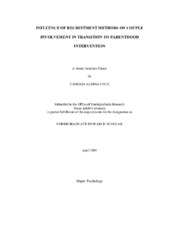| dc.description.abstract | Romantic relationship satisfaction plays an important role throughout a person’s life; poor relationship functioning has been linked to numerous psychological and physiological problems. Fortunately, couple interventions have been found to successfully prevent declines in relationship functioning. Despite the availability and positive impact of couple interventions, few couples actually seek couple intervention to deal with or prevent marital distress.
To attract more couples to these interventions, researchers are expanding traditional interventions to serve couples during the transition to parenthood. This is a unique opportunity for intervention because many couples are already seeking birth and parent education programs and may be more receptive to participating in a relationship intervention program than at other life stages. However, little is currently known about what types of expectant parents seek interventions or the most effective way to attract high-risk couples.
Using data from a larger study examining the differential effectiveness of couple- and parenting-focused intervention programs during the transition to parenthood, this study examines whether certain types of recruitment are especially effective in attracting diverse and high-risk couples to the intervention. The larger study utilizes four different methods of advertisement: pamphlets distributed to local OB/GYN offices, flyers posted around town, announcements at childbirth classes, and flyers posted at community agencies targeting lower income couples (e.g. WIC). To date, 384 heterosexual individuals have been recruited and screened for possible participation in the larger study. Data for the present study was obtained from these screenings.
For both men and women, results indicated that different methods of advertisement resulted in significantly different amounts of pregnancy desirability, marital status, and history of parental divorce. Results also indicated that different recruitment methods resulted in varying prevalence of men’s reported violence in their family of origin and women’s level of relationship satisfaction. Tests of individual group differences suggested that couples recruited through flyers posted around town and community agencies targeting lower income couples consistently had more risk factors than couples recruited through childbirth classes and OB/GYN offices.
These differences suggest ways to improve recruitment methods and will provide researchers with the information needed to reach a larger, more diverse community. | en |


